It all began with a turmeric ginger bug and the ginger beer fermented from it in May 2015. Seven years later, it's really about time that I share the recipe and a few tips and tricks with you. The ginger turmeric beer on the next photo is actually it: The very first beverage that I fermented completely myself. The taste, but especially the production process, got me so hooked that I've been fermenting and trying out all sorts of things almost daily ever since. If you follow me on instagram, you know what I'm talking about 😉
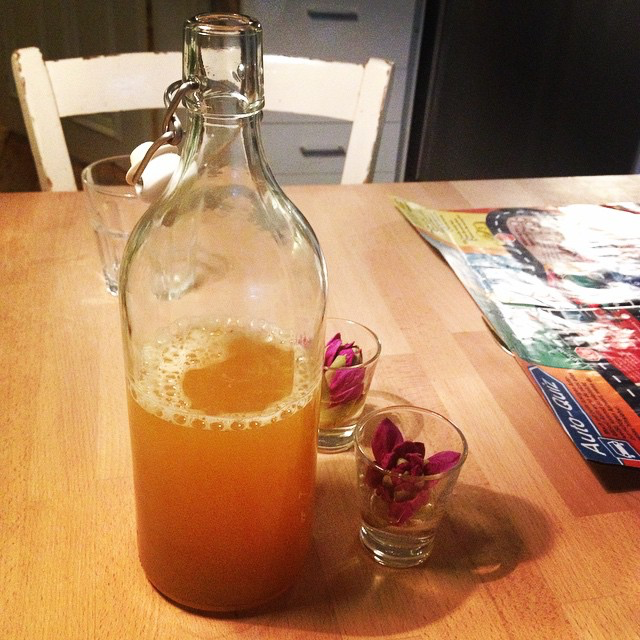
Grow a ginger beer starter aka ginger bug yourself
When ginger, sugar and water are mixed and left to stand, the wild bacteria and natural yeasts on the ginger and from the environment itself begin to multiply. These wild microorganisms metabolize the sugar, producing carbon dioxide that gives homemade soft drinks their bubbles. A million times better than added carbon dioxide. The comparison is like champagne to carbonated table water. Like champagne, this ferment also has alcohol. That's usually as much or as little as is contained in kombucha or non-alcoholic beer.
To produce a fermented beverage, you first cultivate the starter (in English, by the way, it is called ginger bug). The principle is the same as sourdough. So if you've ever brought flour and water to life, you're sure to succeed with the Ginger Bug. I sometimes feel like Lady Frankenstein with these ferments and shout it’s alive! enthusiastically when the active phase begins.
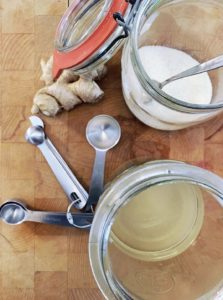
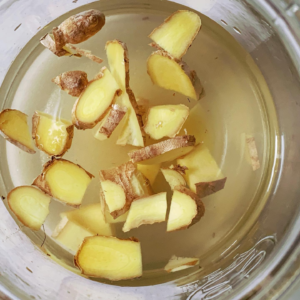
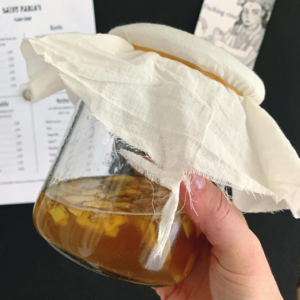
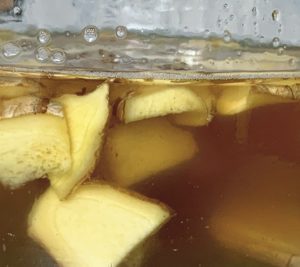
Ingredients
- 2 cups of water
- 1 tbsp. sugar
- 1 tbsp. fresh organic ginger *
* It is important to use organic ginger because it is processed unpeeled. Valuable microbes sit on the skin, which support the fermentation. Conventionally grown ginger is often contaminated with pollutants and carries mold spores. If you're not using organic ginger and your ginger bug isn't getting active, that could be the problem.
Preparation
Dissolve the sugar in water and stir together with the diced or grated ginger in a large glass jar. Cover the vessel with a cloth and fix it with a rubber band. Air and wild yeasts should reach the starter, but pests must be kept away. Be sure to set up warm (20 ° C - 25 ° C is optimal).
Feed every day with
- 1 tbsp. sugar
- 1 tbsp. organic ginger, diced
and stir vigorously several times a day. This is all about the submixing of oxygen. After 3 - 5 days the first bubbles should form and the ginger bug should smell of yeast and ginger. As soon as the starter has so many bubbles that it starts foaming, it is ready to be used for making hard lemonade.
If your starter doesn't get going at all, make sure it's warm enough and try shaking it vigorously instead of just stirring it. A lid on the container is a good idea for this.
Good luck with your first ginger starter!
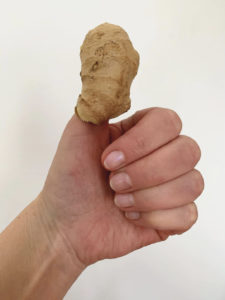

How is the remaining Ginger Bug stored?
The maintenance of a ginger bug actually works just like that of a sourdough. You can store it in a glass with a loose lid in the refrigerator. Once a week it is taken out and fed, which means that sugar and chopped ginger are mixed again with strong stirring. I usually keep it warm for 1-2 hours before I chill it again.
But you probably make a drink at least once a week anyway, so that you can feed it right away on the occasion. Enjoy it!
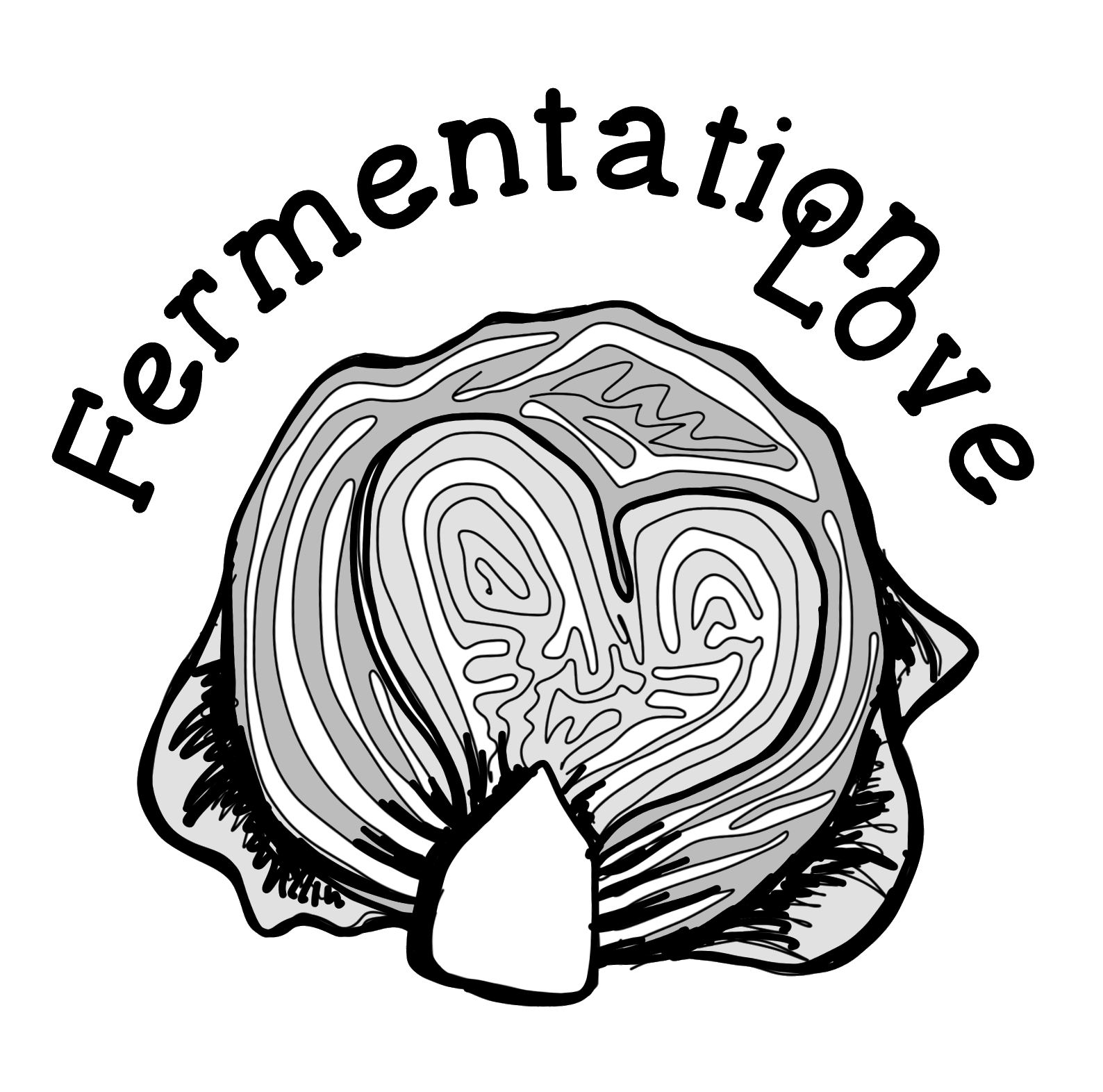
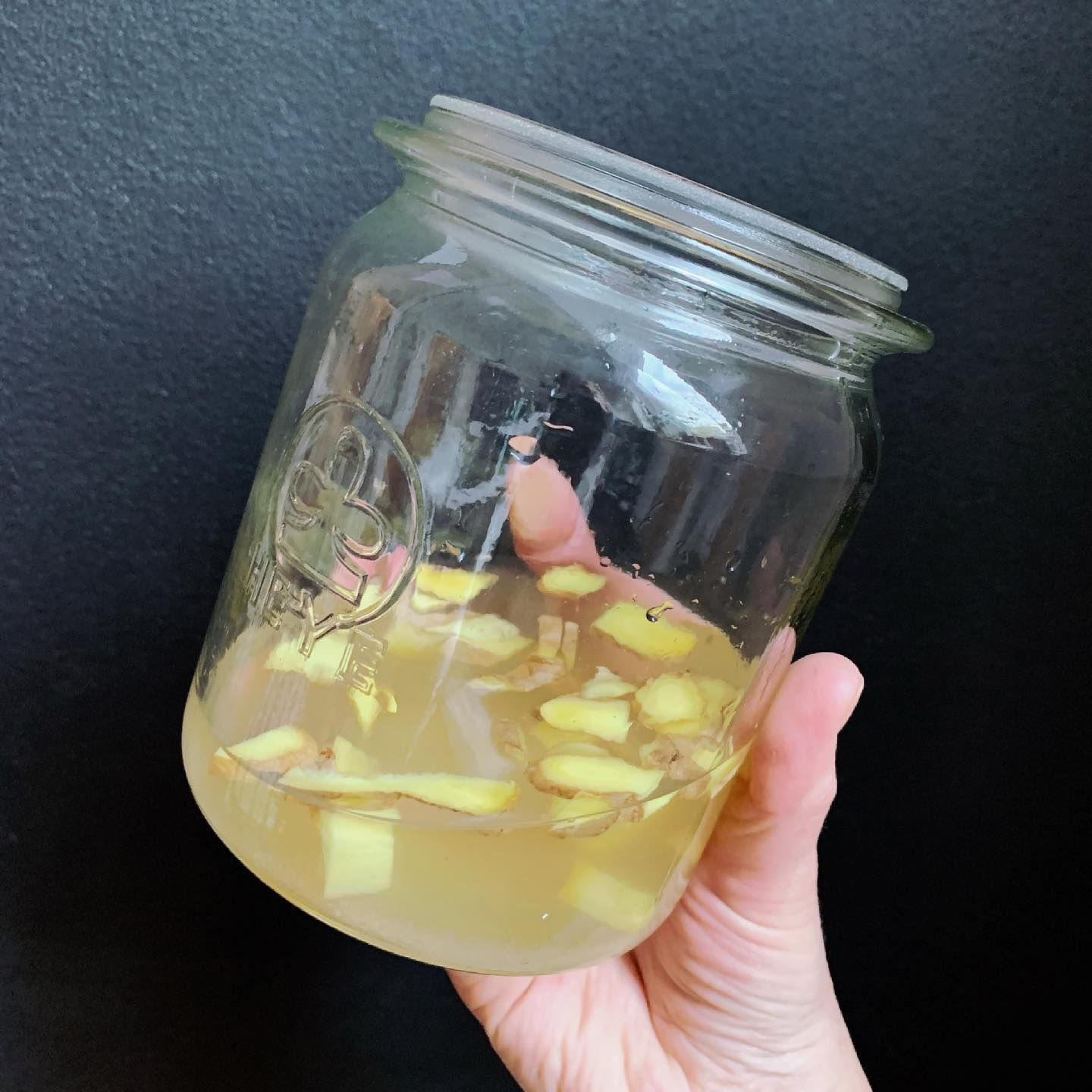
Die Rezepte gefallen mir sehr gut.
Danke, liebe Sonja.
Hallo Katsu,
Wenn man den Ginger Bug wöchentlich mit Zucker und Ingwer füttert, dann nimmt er doch eigentlich nicht an Volumen zu, oder? Muss da nicht auch noch Flüssigkeit (Wasser) zugegeben werden?
LG
Hej,
ja klar, da hast du Recht, Wasser sollte man zwischendurch auch irgendwann mal auffüllen. Ich ergänze das, danke!
Gutes Gelingen,
Katsu
Hallo Katsu, bei mir ist der Ansatz vom Ingwerbeer geliert, wie kann ich mir das erklären? Ist vorher schon ein paar mal gut gelungen… Diesmal relativ viel Ingwer drin. Gruß, Pinita
Hej Pinita,
das ist ein relativ gängiges Phänomen, verantwortlich dafür sind Pediokokken: https://de.m.wikipedia.org/wiki/Pediokokken
Die Phase kann vergehen und danach kann der Geschmack besonders gut sein, es dauert jedoch meistens recht lange und gelingt nicht immer. Ich würde vielleicht einen zweiten Ansatz machen und den gelartigen irgendwo weit weg aufstellen, damit die Bakterien nicht gleich wieder überspringen.
Gutes Gelingen!
Katsu
Hallo,
Meine erstes Ingwerbier ist super geworden. Allerdings hat Inette, mein Ingwer-Bug angefangen im Kühlschrank zu schimmeln? Was kann ich tun damit das bei meinem neuen Ginger Bug, Phönix-Inette, nicht passiert?
LG
Yvy
Hej Yvy,
warum der Bug schimmelte, kann ich nur raten. Hatte er Kontakt zu Sauerstoff? Hat eventuell etwas in deinem Kühlschrank geschimmelt und du hast die Sporen nicht gründlich entfernt, so dass sie sich unsichtbar halten konnten und den Bug erobert haben?
Schreib gerne noch mehr Details, dann kann ich dir weiterhelfen.
Katsu
Hallo Katsu,
Vielleicht war es mein Käse, der nicht weit entfernt gestanden ist.
Meinem neuen Ginger Bug geht es gut und ich habe mittlerweile literweise Ingwerlimo/Bier gemacht.
Ich rühre aktuell den Bug jeden Tag um und seitdem ich das mache scheint alles gut zu sein. Es kann aber auch am Käse gelegen haben, der mittlerweile gegessen wurde. 🙂
Ich finde deine Seite ganz wunderbar und werde mich demnächst mal an Kimchi versuchen.
Liebe Grüße
Yvy
Das freut mich! Weiterhin gutes Gelingen und viel Freude am Fermentieren wünsche ich dir.
Liebe Katsu,
Ich hätte noch eine Frage: mein Ginger Big ist jetzt schon fast 3 Monate alt. Langsam fängt er an nach Essig zu schmecken. Die Ingwerlimo, die ich mit dem Gunger Bug anrühren bildet noch Blubberblasen. Soll ich lieber einen neuen Ginger Bug ansetzen? Habe ich jetzt Ingweressig?
Liebe Grüsse
Yvy
Hej Yvy,
dein Ginger Bug könnte tatsächlich anfangen, zu Essig zu werden. Das kann passieren, wenn wilde Bakterien oder Hefen reinkommen, die in der Luft rumschwirren. Oder wenn der Ginger Bug zu lange Sauerstoff ausgesetzt ist. Denn genau so wird wilder Essig gemacht, aus einer alkoholischen Flüssigkeit mit Sauerstoffzufuhr.
Darum ist es wichtig, den Ansatz, wenn die Fermentation fertig ist, verschlossen im Kühlschrank zu lagern. Wenn er noch funktioniert und nicht nach Essig schmeckt, kannst du ihn noch benutzen, sonst setze lieber einen neuen an.
Gutes Gelingen!
Katsu
Hallo Katsu,
Danke für die schnelle Antwort.
Ich denke ich mache einen neuen Ginger Bug und aus dem alten mache ich dann komplett essig, weil lecker schmeckt der schon irgendwie. 😉
LG
Yvy
Hallo hast du da einen gummi dichtungs Deckel für dein Rex glas?
wo gibts den sowas?
glg Stefanie
Hej Stefanie,
das sind zwei verschiedene Gläser. Das Bügelglas hat ein Gummi, das Rexglas bedecke ich mit Tuch und Gummiband drumrum.
Viel Spass beim Ausprobieren!
Katsu
Moin Katsu
Hast du versuchst danach daraus Ingwer Essig zu machen?
Moin David,
das habe ich noch nicht gemacht, finde die Idee aber naheliegend und super! Mach mal, und berichte, wie es geworden sein wird.
Gutes Gelingen!
Katsu
So ich berichte erstmal
Mein Ingwerbug bugt… er will nicht so richtig.
Ich werde nochmal Bio Ingwer Kaufen und rein tun.
Ich weiß auch nicht wie doll es blubbern sollte, bei meiner gab es nur ein paar Bläschen an der Oberfläche bis jetzt.
Liebe Grüße – Der David aus “Fermentieren in Einfach”
Moin David,
warm genug steht der Ansatz? Das ist wichtig. Versuch mal, ihn kräftig zu schütteln, mit Deckel natürlich. Das hilft manchmal.
Gutes Gelingen!
Katsu
Hallo,
Mein Bug scheint geglückt zu sein. Habe nun den Bug in das abgekühlte Ingwer Zucker Gemisch gekippt. Leider entwickelt sich keine Kohlensäure. Leider das zweite Mal schon so gelaufen. Was mache ich falsch? Danke, Flo
Hej Flo,
wenn dein Ginger Bug aktiv ist, das Ginger Ale aber nicht gelingt, gibt es ein paar Faktoren, auf die du achten kannst.
Häufig ist es Zeit. Manchmal kann es länger als 1-2 Tage dauern, bis sich Bläschen im Ginger Bug bilden. Du könntest das Gefäß weiterhin warm halten und ab und zu umrühren, um den Gärungsprozess zu unterstützen.
Die Temperatur hat auch einen Einfluss auf die Gärung. Stelle sicher, dass das Gefäß an einem warmen Ort steht, idealerweise bei Raumtemperatur oder etwas darüber. Eine zu niedrige Temperatur könnte die Gärung verzögern.
Und achte darauf, dass alle verwendeten Utensilien und das Gefäß sauber sind. Unsaubere Gerätschaften können das Wachstum unerwünschter Mikroorganismen fördern und die Gärung behindern.
Viel Erfolg!
Katsu
bei mir haben sich auch im Uransatz eine Art Schlieren gebildet. Dann wurde draus eine fadige Masse, die allerdings auch kleine Ingwerstückchen enthielt (waren vermutlich zu klein geschnitten). Vorsichtig entfernt und das Fadengebilde weiter gepflegt. Jetzt hat sich eine richtige Essigmutter gebildet und ich setze parallel zum Ingwerbier Ingweressig an.
Wie auch Kombucha-Essig. Das gibt den Salaten ganz neue Noten!!!
Danke für die Anleitung. Das klingt gut. Ich habe den Ginger Bug angesetzt und auch schon erste Bläschen. Ich bin schon sehr gespannt. Eine Frage zum letzten Schritt: ich nehme an, dass die Ingwerscheiben, wenn das Ginger Beer in Bügelflaschen abgefüllt wird, nicht mit in die Flaschen wandern, oder doch?
Liebe Jessica,
das kannst Du tatsächlich halten, wie ‘n:e Dachdecker:in. Entweder siebst Du die Stücke raus, oder Du lässt sie drin. Ich mache es mal so, mal so, es macht nicht wirklich einen Unterschied. Trinkt sich einfacher ohne.
Liebe Grüsse und gutes Gelingen!
Katsu
Super, danke dir.
Hi,
Wenn der Ginger Bug fertig in den Kühlschrank wandert, wurde er dann vorher komplett abgeseit? Und wenn er dann wöchentlich gefüttert wird, wie lange können Ingwerstücke da drin bleiben?
Liebe Grüße
Hej Vans,
der Ingwer kann drin bleiben. Irgendwann wird es recht viel durch das Füttern, dann kannst du etwas von dem alten entsorgen (macht sich gut als Ballaststoff in Gebäck) und durch frischen ersetzen.
Gutes Gelingen!
Katsu
Vielen lieben Dank!
Das ist ein super Tipp
Hat super geklappt. Seeehr lecker und mit Kaufprodukten tatsächlich nicht zu vergleichen. Vielen Dank!
Hej Jessica,
das freut mich sehr!
Lass’ es Dir schmecken,
Katsu
Hallo miss ich das Wasser für den starter aufkochen und dann abkühlen lassen?
Hej Gisela,
nein, das Abkochen des Wassers ist bei guter Trinkwasserqualität nicht nötig.
Viel Erfolg!
Katsu
Love your recepies✌️ So when maintaing the ginger bug do you add 4 tbs of fresh water everytime you take out 4 tbs of ginger bug for a new batch of ginger ale etc?
Thanks Anders! I don’t add it right back every time. Usually I feed my starter once a week and I just take some out when I want to make lemonade. But there’s no right and wrong here, you can just find a way how it works for you. If that means feeding it when you take some out, that’s also fine.
Happy fermenting <3
Katsu
Danke für dein Rezept. Warum muss ich den Ingwer kochen? Den Ingwer Bug lass ich ich doch auch natürlich fermentieren? Hast du schon mal den Starter und den anderen Ingwer ohne Kochen zusammengekippt?
Hej Andreas,
für das Ginger Beer koche ich aus Ingwer, Zucker und Wasser einen Sirup. Durch das Kochen wird die Konzentration der Wirkstoffe stärker, und der Geschmack damit natürlich auch schärfer. Wenn Du ein milderes Getränk bevorzugst, dann kannst Du diesen Schritt überspringen.
Gutes Gelingen!
Katsu
Vielen Dank für den Tipp! Dann werde ich das mal so versuchen und zwar mit Wasserkefirkristallen. Der letzte Ingwerbug hat nicht richtig gezündet, hab´s dann mit Trockenhefe probiert (bitte nicht steinigen ;-)). Hat gesprudelt wie jeck, allerdings dann -wie zu erwarten- mit einem Hefenachgeschmack. Ist halt eine Backhefe und dafür optimiert.
Du machst, was Dir schmeckt. Ich habe auch ein superleckeres Gazosa-Rezept mit Hefe. Das wird halt alkoholischer 🙂
love you recipe. Thanks for sharing
Hallo Katsu,
mein Ginger Bug ist fast fertig… weil mir das mit der Namensgebung so gut gefallen hat, hat er auch einen Namen bekommen, er heißt “Buddy”.
Wenn ich ihn nun in den Kühlschrank stelle und regelmäßig füttere, dann werden das ja immer mehr Ingwerstücke. Seihe ich ihn immer mal ab, oder wie machst Du das?
Danke und liebe Grüße
Anke
Ja, genau. Du kannst die Stückchen dann auskochen und als Ingwertee geniessen. Oder pürieren und damit backen. Ich wünsche Dir, dass Buddy Dein Buddy für lange Zeit wird, ich mag den Namen!
Hallo liebe Katsu, ich nochmal:
Mein Ginger Ale ist fertig – Bläschen sprudeln, alles hat gut geklappt. Aber geschmacklich – na ja. Es schmeckt etwas wie angegorener Most, ein wenig herb und etwas alkoholisch. Meine Kinder haben sich gleich abgewendet.
Habe ich was falsch gemacht?
Dank und besten Gruß!
Hej Anke,
das klingt fast, als sei der Ingwer vielleicht nicht ganz frisch gewesen? Hefig soll es schmecken, angegorener Most ist allerdings nicht die Geschmacksrichtung.
Vielleicht probierst Du noch eine Zweitfermentation mit sehr frischem Ingwer und etwas mehr Zitrone.
Gutes Gelingen!
Katsu
Liebe Katsu, der nächste Versuch ist prima geworden! Ich glaube, beim ersten ist mein Ale einfach zu lange gestanden, es hat nicht richtig gestartet … warum auch immer. Jetzt klappt es richtig gut, und es schmeckt auch!
Also an alle, denen es auch so geht: noch einen Versuch machen. Manchmal braucht gut Ding Weile…
Herzliche Grüße von Anke
Hallo Katsu, mittlerweile klappt es mit dem Ingwer-Buzz, Trockenhefe brauche ich nicht mehr. Jetzt habe ich folgenden Hinweis gefunden: Zur Steigerung des Alkoholgehaltes solange im Glas fermentieren lassen bis das Blubbern aufhört (also nicht nach 2 Tagen in Flaschen umfüllen). Nach dem Umfüllen in die Flaschen zum Nachkarbonisieren Zucker hinzufügen. Schon mal ausprobiert? Wenn ja, welche Zuckermenge wäre da sinnvoll?
Hej Andreas,
so mache ich Bier, also Pale Ale. Dafür nehme ich 6-8 gr. Haushaltszucker pro Liter. Keine schlechte Idee, das mal mit Ginger Ale zu probieren! Sei bitte trotzdem vorsichtig, dass Dir die Flaschen nicht explodieren beim Gären.
Meine Vorgehensweise kannst Du hier nochmal nachlesen https://fermentation.love/bier/pale-ale/#abfuellung_zur_flaschengaerung_und_zum_karbonisieren.
Gutes Gelingen, und bitte berichte, wie es wird. Ich find’s super!
Katsu
Nach 6 Tagen Blubberei – und noch immer nicht zu Ende!- habe ich das Gebräu ohne Zucker in Flaschen abgefüllt und zur Karbonisierung stehen lassen. Restzucker reichte immer noch aus. Jedoch war mir der Geschmack zu “trocken”. Ich werde in Zukunft wieder nach drei Tagen abfüllen für einen halbtrockenen Geschmack ;-).
Versuch macht kluch 🙂
«Ingwer, Zucker und Wasser etwa 10 Minuten sanft sprudelnd kochen»
aus welchem Grund “kochen” ??? Mit Invertzucker gehts auch ohne kochen, oder?
Na, Du willst doch den Geschmack des Ingwers haben, den kochst Du aus. Mit Invertzucker hab ich nix am Hut, da musst Du bitte woanders forschen, aber ob der ungekocht das Aroma des Ingwers rausbekommt, wage ich zu bezweifeln?
Tolles Rezept. Versuche mich gerade daran 🙂
Wenn du deinen Ginger Bug pflegst, fügst du auch die entnommene Menge Wasser wieder hinzu? Kann es mir nicht anders vorstellen, aber ich frage lieber nach.
Danke! Ja, genau, es wird immer mal wieder Wasser hinzugefügt, dass eine Balance der Zutaten bleibt. Ich überarbeite die Anleitung demnächst und präzisiere den Punkt. Danke für die Rückfrage!
Hallo liebe Katsu,
leider kann ich nicht zu deinem Fermentier-Workshop kommen, dafür ist es einfach zu weit – sehr schade! Aber ich schicke eine Freundin 🙂
Frage zum Ginger Bug: kann ich damit auch andere Sprudelgetränke machen, und statt Ingwersirup anderen Sirup nehmen? Der Sommer kommt und ich hab richtig Lust auf tolle Getränke!
Danke und herzliche Grüße aus dem Süden!
Hej Ankecaro,
wie schön, ich freue mich auf deine Freundin. Ja, du kannst den Ingwerbug für alles mögliche benutzen und Getränke nach deiner Fasson fermentieren. Auch mit Molke kann man süsse Brause machen, https://fermentation.love/getraenke/fermentierte-limonaden-und-wasserkefir/#probiotische_limonade_mit_molke_ansetzen.
Viel Spass beim Experimentieren und herzliche Grüße,
Katsu
Hallo,
Danke für die Anleitung, hat super geklappt, blubbert schön und riecht fein. Der Ansatz ist denk ich fertig, nun zur Lagerung… wenn ich den in den Kühli stelle, lasse ich dann den ganzen Ingwer drin oder seihe ich das ab?
Danke LG A
Hej Anna,
wenn du die Flasche öffnest, um den Ingwer rauszufischen, geht auch die Kohlensäure flöten. Ich lasse den Ingwer drin und schütte durch ein Sieb in die Gläser beim Trinken.
Lass es dir schmecken!
Katsu
Den Ansatz seihst du erst ab, bevor du in in den Flaschen abfüllst. Richtig?
Ja, genau. Gutes Gelingen!
Danke!
Kann ich den (Metall-)Topf als Gefäss verwenden, indem ich den abgekochten Sud mit dem Tuch abdecke und stehen lasse oder sollte es ein nicht-metallisches Gefäss sein?
Übrigens: Ich liieeebe deine Rezepte !!! Von deinem Kefir-Frischkäse esse ich täglich, ich wollte etwas Abwechslung zu: jeden Tag Kefir trinken …
Ich mag ihn gerne mit viel Schnittlauch oder fein gewürfelten Zwiebeln und viel Thymian … oben drauf mache ich immer noch ca. 1 cm Olivenöl in das Glas … esse ihn gerne auf gut getoastetem Vollkornbrot mit frisch gemahlenem Pfeffer … hmmmmmm so lecker !!!
Als nächstes will ich deine Tomatensalsa probieren und sie oben auf tun … stelle mir das mega lecker vor … Danke für diese Bereicherung
Hej Jule,
ich benutze gerne Glasgefässe, da kann man den Fortschritt am besten beobachten. Gerade am Anfang hilft das sehr! Im Metalltopf müsste es theoretisch auch funktionieren, wenn er aus Edelstahl ist, aber ausprobiert habe ich es noch nicht.
Ich finde es klasse, dass dir meine Ideen so gut gefallen! Frischkäse mit Salsa ist ein Supersommersnack.
Fröhliches Fermentieren,
Katsu
PS. Du weisst es wahrscheinlich, ich möchte es trotzdem nochmal erwähnen: Öl darf wegen der Botulismusgefahr nur bei komplett ausfermentierten Lebensmitteln benutzt werden.
Wann weiss ich denn, wann mein Frischkäse komplett ausfermentiert ist? Oder wird er das überhaupt? Woran erkenne ich denn generell eine komplette Fermentation? Ich freue mich so auf Donnerstag, da gibt es Gehalt … habe das WE schon komplett zum Fermentieren geplant, welche Zutaten und Utensilien ich benötige, ich hab mir einiges vorgenommen … übrigens: mein vorletzter Kefir-Ansatz war irgendwie komisch, hatt erst viel Molke gebildet, dann hab ich mit einem Holzlöffel umgerührt und dann ist er irgendwie wieder ganz flüssig geworden und es bildet sich kaum noch Molke (und auch nicht wie gewohnt unten sondern oben) … was meinst du: soll ich diesen Ansatz verwerfen? Es sind immerhin 3 Liter … der nächste Ansatz ist wieder gut geworden (ich hab ihn mit dem gleichen Holzlöffel umgerührt)
Moin Jule,
wenn sich keine Aktivität mehr zeigt, ist die Fermentation abgeschlossen. Der Käse verändert dann Geschmack und Aussehen nicht mehr.
Beim Umrühren mit dem Holzlöffel hast du eventuell so gut gerührt, dass du den Kefir homogenisiert hast? Was war denn der Grund für das Rühren? Ich seihe den Kefir meistens ab, wenn er sich trennt, ohne ihn viel zu bewegen.
Viel Erfolg beim nächsten Versuch!
Katsu
Hallo!
Vielen Dank für das Rezept!
Im Kühlschrank hört der Bug bei mir recht schnell auf zu blubbern,
muss ich ihn bevor ich ihn als Starter verwenden kann erst wieder ein paar Tage warm stellen und füttern damit er wieder beginnt zu blubbern?
Oder kann ich ihn nicht blubbernd direkt aus dem Kühlschrank verwenden?
Vielen Dank und liebe Grüße!
Hej Karl,
ja, wie bei Sauerteig kann es eine gute Idee sein, den Starter erst zu reaktivieren. Wärme ist da super, und einmal füttern hilft auch.
Gutes Gelingen!
Katsu
Liebe Katsu,
ich habe schon einige Deiner Tipps und Rezepte ausprobiert. Bin über Milchkefir zum Fermentieren gekommen. Neben Sauerkraut, Kimchi und Fenchel ist das Gingerbeer mein absoluter Favorit! Und ich mag einfach sehr gerne auf deiner Webseite lesen, weil dein Schreibstil großartig ist! Also superlieben Dank für deine tolle Webseite und deinen stets anregenden Insta-Kanal! Mein Tipp für das Ingwerbier: Ab der dritten Ladung habe ich angefangen, ein wenig zu experimentieren. Wenn man dem brodelnden Ingwertee einige getrocknete Hibiskusblüten spendiert (haben wir in Ägypten als Tee geschenkt bekommen), erhält die fertige Limo zwar kaum ein blumiges Aroma (der Ingwer haut das ziemlich weg), aber eine wundervolle pinke Farbe, etwa wie eine rosa Grapefruit. Sehr ansprechend! Und natürlich sehr lecker! Die ganze Familie ist süchtig nach dem Ingwerbier! Liebe Grüße, Newcomer-Fermentista Claudia
Hej Claudia,
vielen Dank für dein tolles Feedback! Wie schön, dass dir das Fermentieren soviel Freude macht <3
Und danke für den Tip mit dem Hibiskus, das ist eine gute Inspiration.
Weiterhin viel Freude mit deinen Fermenten,
Katsu
Super lecker, das Ingwer-Bier (nach dem Abseihen habe ich mit den übrig verbliebenen Ingwerstückchen Ingwer-Kekse gebacken) –
Im Ginger-Bug hat sich oben ein mycel-artiges hautiges Etwas gebildet.. mit Fäden, aber kein Schimmel, aber auch nicht so gallerig, wie eine Essigmutter… was könnte das sein?
Ich hab es mal getrennt und zückte/beobachte es weiter….
Hej Jürgen,
das klingt wie eine Kultur aus Hefen und Bakterien, also ähnlich wie eine Essigmutter oder ein Kombuchascoby.
Geniesse dein Ingwerbier!
Katsu
Danke für das Rezept und die tolle, schön zu lesende Beschreibung! Damit habe ich nun ein paar mal leckeres Ginger Ale gemacht und bin nun angefixt. Ich hab auch mal rumprobiert und mit Orangenzesten oder Granatapfelsirup gemischt, aber das Original „nur“ mit Ingwer und Zitronensaft gefällt mir am besten und wird oft gemacht. Ich koche noch nicht einmal Sirup, sondern mische es direkt mit lauwarmem Wasser, auch wenn es mit gekochtem Sirup ein kleines bisschen feiner wird, wie ich finde.
Mich würde interessieren, ob du oder jemand anderes hier Erfahrung damit hat, es statt in Bügelflaschen in Saftflaschen mit Gummiring und Klemmen wie zB von Weck anzusetzen? Die lassen ja Überdruck ab? Ich überlege das, weil man dann evtl keine Sorgen um explodierte Flaschen haben müsste, wenn man ein paar Tage weg ist und die Flaschen nicht Bäuerchen machen lassen kann …? Und könnte sich bei der Rückkehr auf was leckeres zum Trinken freuen. Deshalb interessiert mich das und beim Fermentieren funktioniert es ja auch? Vielleicht entweicht aber zu viel/zu wenig Kohlensäure?
Hej Lina,
Ginger Bug Brause ist wirklich vielseitig und fabelhaft. Probiere es mal aus in den Weckflaschen. Da wilde Hefen im Spiel sind, kann der Druck trotzdem ganz schön gross werden, ob der Gummiring das abfedern kann, weiss ich persönlich nicht. Wenn ich Tepache im Bügelglas mache, lasse ich tatsächlich immer mal Druck ab, ohne wäre mir zu riskant.
Vielleicht kann ja noch eine andere Person hier helfen. Falls du bei Facebook bist, komm gerne in unsere Gruppe, da ist der Austausch rege.
Gutes Gelingen!
Katsu
Tag 5 – noch ist nichts explodiert. Ich hab eine Flasche bei Zimmertemperatur in einen Eimer mit Holzbrett obendrauf gestellt. Allerdings habe ich auf Vorrat gekochten Sirup genommen und keine zusätzlichen Ingwerstückchen genommen. Ich hab den Eindruck, das arbeitet nicht so stark, eine „Vergleichsflasche“ war mir nach 3 Tagen noch zu süß. Es bleibt spannend …
Liebe Katsu,
ich bin “Fermentations-Frischling” : habe letzten Samstag einen Fermentationsworkshop gemacht und in einem blubbert Weißkohl (klassisches Sauerkraut hoffentlich demnächst) und im anderen Möhre mit Lauch und Fenchel in Salzlake vor sich hin (wobei im Möhren-Glas mit Lake die Glasbeschwerung verrutscht ist und nun ein Teil des Gemüses oben schwimmt…ich lass es einfach mal so). Wir haben auch einen Ginger-Bug angesetzt. Auch der blubberte wunderbar bis z um zweiten Tag. Nun NICHTS mehr. Ich füttere tgl. (heute 5. Tag) mit jeweils 1Eßl Zucker un 1 Eßl Ingwerstückchen. Sollte es nicht eher mehr als weniger Bläschen geben? Sollte ich nun weiterfüttern?
Im Übrigen finde ich deine Website super! Vor allem wunderbar praxisnah und bodenständig (so mancher empfiehlt gleich teure Spezialgläser etc…). Gruß aus dem Ruhrgebiet
Liebe Sabine,
herzlichen Dank, das freut mich, dass dir meine Seite weiterhilft.
Für die Beantwortung deiner Frage möchte ich dich an die Person verweisen, deren Workshop du besucht hast – die Nachbetreuung gehört für mich unbedingt dazu.
Gutes Gelingen!
Katsu
Hallo Liebe Katsu
Ich habe schon erste positive Resultate mit einem Ginger/Kurkuma Bug gemacht. Aktuell ist mein Bug dickflüssig geworden – wie Gelee und auch das Gingerbeer wird nach 1-2 Tagen dickflüssig. Ich habe den Geschmack auf der Zunge getestet: das Gel-bier ist süsser und hat wenig Kohlensäure. Hat jemand sowas schonmal beobachtet oder weiss jemand was das sein kann?
Vielen Dank für die informative Webseite und viele Grüße!
Hej Bernhard,
lies mal den 6. Kommentar, da erkläre ich das Phänomen. Es handelt sich höchstwahrscheinlich um Pediokokken.
Gutes Gelingen!
Katsu